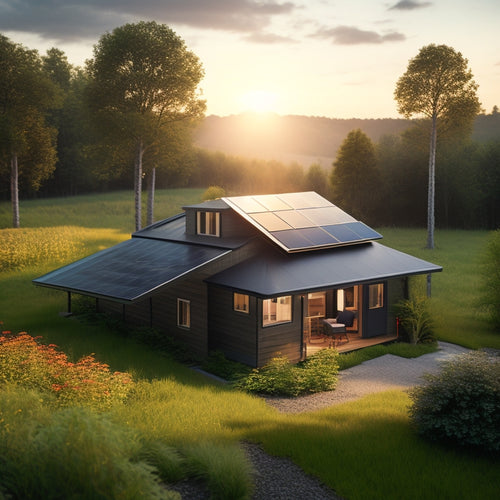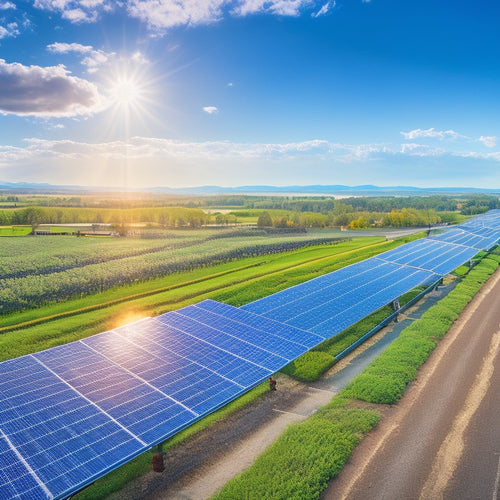
DIY Home Energy Independence Kit Guide
Share
You're taking an important step towards reducing your reliance on the grid and minimizing your carbon footprint by exploring DIY home energy independence. By combining solar panels, wind turbines, battery storage, and an energy management system, you can achieve self-sufficiency in energy use. When designing your solar system, take into account factors like energy needs, sunlight availability, and panel selection. Proper installation, including permits and electrical connections, is vital for a safe and efficient setup. As you begin assembling your kit, you'll need to think about essential components, installation guidelines, and energy storage options - and that's just the beginning of your expedition towards energy independence.
Overview
- A DIY home energy independence kit typically includes solar panels, wind turbines, battery storage, inverters, and an energy management system.
- Selecting the right solar panels involves considering efficiency, durability, and cost, with high-efficiency panels recommended for DIY setups.
- Proper installation of the kit requires permits, safe electrical connections, and optimal mounting of the solar array for maximum energy harvesting.
- Monitoring the system's performance is crucial to optimize energy generation and identify potential issues, with data analysis helping to enhance system performance.
- The initial investment for a DIY home energy independence kit can range from $15,000 to $30,000, but long-term savings and incentives can provide a significant return on investment.
Choosing the Right Solar Panel
When selecting a solar panel, you'll encounter a multitude of options, each boasting unique characteristics that can considerably impact your DIY home energy independence project.
You'll need to take into account various solar panel types, such as monocrystalline, polycrystalline, and thin-film, each with its own efficiency ratings. High-efficiency solar panels from brands like SunPower, Panasonic, and LG are recommended for peak performance, as they guarantee durability and consistent power output certifications from UL or IEC.
Installation costs, environmental impact, and maintenance requirements are also vital factors to weigh. Efficiency ratings range from 15% to 20%, with higher ratings often coming at a higher cost.
Additionally, warranty options, aesthetic considerations, and grid connection requirements should be evaluated. By carefully evaluating these factors, you can choose the right solar panel for your project, securing a reliable and efficient source of renewable energy.
Understanding Energy Storage Options
As you shift from utilizing solar energy to storing it, you'll face another crucial decision in your DIY home energy independence project.
You must choose the right energy storage solution to guarantee a reliable and efficient backup system. Battery technologies like lithium-ion and lead-acid batteries offer varying levels of energy efficiency and storage capacity.
When selecting a storage solution, consider the total cost of ownership total ownership costs and the performance, cost, and maintenance of batteries, as these factors can greatly impact your energy independence goals.
Consider renewable incentives and solar economics when selecting a storage solution that aligns with your grid independence goals. Backup solutions like generators and UPS systems can provide additional peace of mind.
Be mindful of the environmental impact of your storage choice, as it can affect the overall sustainability of your DIY project.
Designing Your Solar System
You'll need to select the right solar panels for your system, considering factors like efficiency, durability, and cost.
High-efficiency panels with extensive warranties are recommended for DIY installations.
To determine the required system size, you'll need to calculate your energy needs, factoring in your daily energy usage and the amount of sunlight your location receives.
Solar Panel Selection
Selecting the right solar panels for your DIY home energy independence kit is an important step in designing your solar system.
You'll need to take into account the type of solar panels that suit your energy needs. There are two main solar panel types: monocrystalline and polycrystalline. Monocrystalline panels are more efficient, but also more expensive. Polycrystalline panels are less efficient, but more affordable.
Solar panel efficiency is also vital, as it determines how much energy you can generate per hour of sunlight. Look for panels with high efficiency ratings (above 20%).
Additionally, take into account the panel's wattage, voltage, and durability. By choosing the right solar panels, you'll be one step closer to achieving energy independence.
System Sizing Essentials
With your solar panels chosen, it's time to determine the ideal system size for your DIY home energy independence kit.
To do this, you'll need to perform a load calculation, which involves calculating your home's energy requirements. This involves identifying the appliances and devices that'll be powered by your solar system, as well as their respective energy consumption rates.
Be certain to factor in energy efficiency measures, such as LED lighting and Energy Star-rated appliances, to minimize your energy needs. A correctly sized system guarantees you'll have enough power to meet your energy demands while avoiding overspending on unnecessary equipment.
Accurately sizing your system is vital to achieving energy independence.
Assembling the Solar Panel Kit
You're now ready to assemble your solar panel kit, an essential step in achieving energy independence.
Follow the manufacturer's instructions to complete the solar panel assembly steps, ensuring all connections are secure and wiring is properly routed.
Next, you'll mount the solar array on your roof or in a ground-mounted rack, carefully positioning it for ideal energy harvesting.
Solar Panel Assembly Steps
Throughout the solar panel assembly process, careful attention to detail is essential to guarantee a safe and efficient energy harvest.
You'll need to prepare the necessary solar panel materials, including the photovoltaic modules, frames, and connectors. Ascertain you have the required assembly tools, such as a drill, screwdriver, and wire strippers, within reach.
Begin by attaching the frames to the photovoltaic modules, securing them with screws and sealants. Next, connect the modules in series and parallel using the connectors, following the manufacturer's instructions.
Inspect the connections for any signs of wear or damage. Finally, perform a series of tests to verify the solar panel's electrical output and integrity.
Mounting the Solar Array
Mounting the solar array requires a sturdy and secure infrastructure to confirm maximum energy harvesting.
You'll need to choose a suitable mounting technique, such as a roof-mounted or ground-mounted system, depending on your roof type and available space.
Ascertain the mounting structure can withstand wind and snow loads, and is compatible with your solar panel kit.
Follow the manufacturer's instructions for installation safety, and take necessary precautions to avoid electrical shock.
Properly secure the panels to the mounting frame, guaranteeing a snug fit and even weight distribution.
Verify the array's angle and orientation for ideal energy production.
Installing the Energy Storage System
Configure the energy storage system by selecting a suitable location for the battery bank, making sure it's well-ventilated, dry, and protected from extreme temperatures.
You'll want to confirm your battery bank is installed in a location that's easily accessible for maintenance and monitoring.
Next, you'll need to select an inverter that's compatible with your solar array and battery bank.
Consider an inverter with a built-in battery management system to optimize energy storage and prevent overcharging or undercharging. Proper inverter selection is vital to guarantee efficient energy conversion and storage.
Once you've selected your inverter, follow the manufacturer's instructions for installation and connection to your solar array and battery bank.
Monitoring Your Energy Output
How will you know if your DIY home energy independence kit is performing at its best? Monitoring your energy output is essential to guarantee you're generating enough power to meet your energy consumption needs.
You'll need to track your system's performance to identify areas for improvement. Invest in a monitoring system that provides real-time data on your energy output, consumption, and storage.
This will enable you to track your energy usage patterns, optimize your system's performance, and make data-driven decisions. Performance tracking will help you identify potential issues before they become major problems.
Frequently Asked Questions
Can I Install the System Myself or Do I Need Professional Help?
You're wondering if you can tackle the installation solo or need expert hands; consider the installation challenges and safety concerns involved, as they may require specialized skills and equipment to guarantee a safe and efficient setup.
How Long Does It Take to Recoup the Cost of the DIY Kit?
As you bask in the glow of energy independence, you wonder: how long until you break even? Conduct a cost analysis, factoring in energy savings, and you'll find that, on average, you'll recoup the cost in 5-7 years, freeing you from the grid's grasp.
Are There Any Local Building Codes or Permits Required for Installation?
When installing your renewable energy system, you'll need to check if local regulations require permits or adherence to specific installation guidelines, ensuring compliance and avoiding potential fines or removal of your setup.
Can I Expand My System in the Future if Energy Needs Increase?
Imagine your energy system as a LEGO castle - you can always add more blocks as your energy demand grows. Fortunately, you've designed your system with scalability in mind, so upgrading is a breeze, and you'll never be held back by outdated infrastructure.
Are DIY Solar Systems Compatible With Grid-Tied Backup Generators?
You'll find that most DIY solar systems are compatible with grid-tied backup generators, ensuring seamless integration; however, it's essential to verify solar panel compatibility and generator integration specifics to avoid potential power output and synchronization issues.
Ready to Buy
You've finally flipped the switch on your DIY home energy independence kit, and the juice is flowing! As you bask in the glow of self-sufficiency, remember that your system is a finely-tuned machine, like a vintage timepiece. With regular maintenance, it'll keep ticking away, generating clean energy and saving you cash. Keep an eye on your monitoring system to guarantee peak performance, and don't hesitate to make adjustments as needed. Now, go forth and utilize the power of the sun like a 21st-century pioneer!
Related Posts
-

Diy Off Grid Solar
By embracing DIY off-grid solar, you can break free from grid dependence, slashing your energy bills by up to 90% and...
-

Top Camping Water Bottles for Adventure
When you're out adventuring, picking the right camping water bottle is essential for staying hydrated. Look for durab...
-

Applications of Photovoltaic Systems
Photovoltaic systems are versatile, converting sunlight into electricity for various applications. You can use them i...


